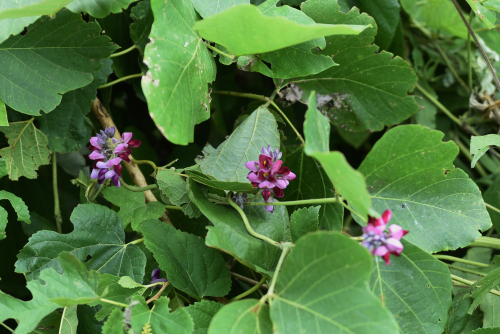
Most of us living in the Washington DC area are familiar with a sight common to the area’s roadsides and parklands. That is, thick blankets of twining, dark green vines covering acres of trees and shrubs. No, it’s not poison ivy, but another species that’s even more invasive. The plant is known as kudzu. And unfortunately, its reputation is spreading.
WHAT IN THE WORLD IS KUDZU?
Kudzu, or Japanese arrowroot, is a perennial vine native to East Asia and the Pacific. Its name comes from the Japanese kuzu. First introduced to the United States in 1876, it was featured in the Japanese pavilion during Philadelphia’s Centennial Exposition. 
Kudzu growing in Mississippi/Photo: Roberto Michel
At the time, kudzu was lauded for its ornamental qualities, which included large, bright green leaves and deep purple flowers.

Flowers and leaves of kudzu
However, about a half century later, farmers discovered that kudzu could also serve as a cheap source of feed for their livestock. Moreover, as the thick vines carpeted the ground, they helped stabilize the soil. As a result, in the 1930s, the United States Department of Agriculture (USDA) began importing the vine specifically to control erosion.

Photo: Oleh Slepchenko for shutterstock
Indeed, from about 1935 to the mid 1950s, the USDA encouraged farmers in the south to plant kudzu on their land, in some cases paying them a subsidy of $8/day. Over 1 million acres of kudzu were planted in this way, as farmers sowed their fields with the invasive vine.
THINGS GOT OUT OF HAND
It didn’t take long for things to get out of hand, though. As the plant spread rapidly throughout the southern states, some people started calling it “The Vine That Ate the South.” Vigorous and attractive, it gobbled up other plants as it reproduced, covering hundreds of acres of land per year.
Map showing kudzu-prone states
Finally in the late 1950s, the plant was recognized as the noxious weed it had become. The Agricultural Conservation Program removed it from its list of acceptable species. Then in 1972, the USDA classified kudzu as a weed.
HOW IT SPREADS
Kudzu now grows primarily in the northeast U.S., where it is invasive in naturalized areas extending from Connecticut to Florida and as far west as Texas. Growing with alarming speed, it has become a serious threat to other native plants. Kudzu spreads by runners that root at the nodes to form new plants. According to the National Park Service, the vines grow as much as 60 feet per season, or about 1 foot per day.
By some estimates, kudzu is now spreading at the rate of 150,000 acres annually. In fact, the plant is easily outpacing attempts to control it either by herbicides or mowing. Left unimpeded, the large-leafed vine easily smothers other species, plunging them into deep shade and depriving them of light. And as it coils itself around tree trunks and other woody plants, it sometimes uproots them entirely.
WHAT GOOD IS KUDZU?
Yet, across the world, kudzu has had many uses, going back centuries in time. The root, which can grow up to the size of a human being, has been an integral part of traditional Chinese medicine for centuries, where it is known as ge gan. Modern medicine also recognizes the kudzu root as a good source of isoflavones, which have shown some promise in treating migraines and cluster headaches.
Still others insist the vine still has value in the landscape, where its deep taproots can help aerate the soil. And it continues to be used to prevent erosion.
KUDZU JELLY AND OTHER USES
Kudzu blooms from the end of July through December, producing purple flowers with a scent reminiscent of grapes. That might explain why there are so many recipes for kudzu jelly. (Food.com has a great recipe for making an unusual jelly.) Some admirers of the vine swear its flowers can also detoxify the liver and help with hangovers.

In Asia, kudzu leaves have been used for centuries to make herbal teas and tinctures. And in Japan, the vine’s root often serves as a substitute for cornstarch.
MAKING ART
Then there is kudzu art. Regina Hines, a textiles artist, provides a wonderful example of what one can do with the vine. For years, she’s be weaving it into baskets, jewelry and other vessels. Her stunning work has been featured in galleries, museums and art centers across the country.
Kudzu art by Regina Hines
A WORD OF WARNING: Before you go out foraging in the hillside for kudzu for medicines, tea, jelly or art, first make sure that it hasn’t been sprayed with herbicides.





